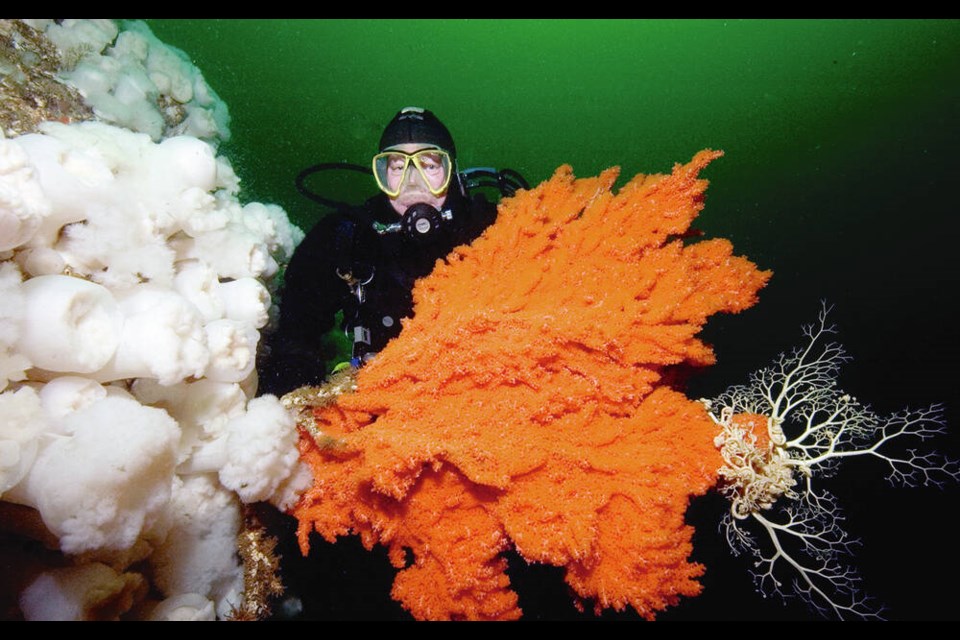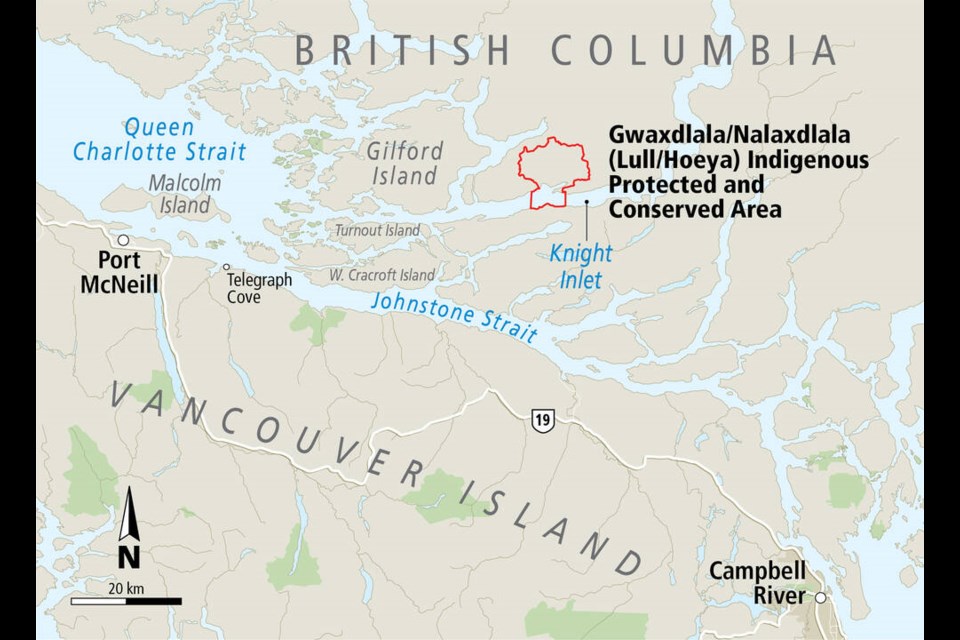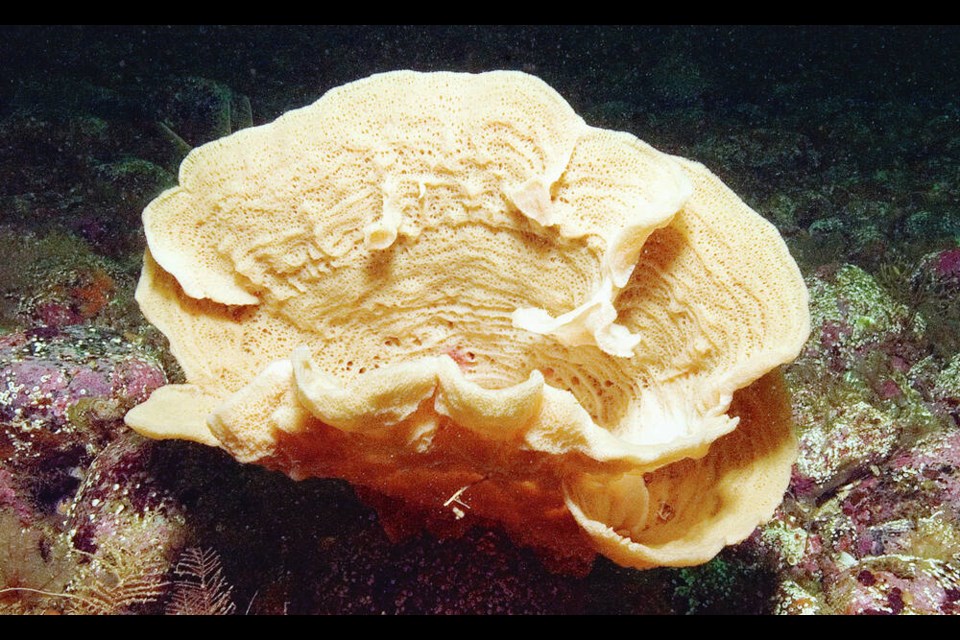Heavy prawn traps and ropes are destructive to the delicate red tree corals
Rochelle Baker, Local Journalism Initiative Reporter,











A remarkable coral garden tucked away in a remote inlet on B.C.’s wild central coast is in danger unless the federal government takes immediate steps to save it from destruction before the prawn fishing season gets underway, conservationists say.
Heavy prawn traps and ropes, which make contact with the seabed, are particularly destructive to the delicate red tree corals, or Primnoa pacifica, in a unique area in the centre of Knight Inlet, said professional diver, filmmaker and naturalist Neil McDaniel.
The bright orange coral fans in the relatively shallow waters of the Hoeya Head Sill are unusually large, stretching nearly two metres across and 1.5 metres high, McDaniel said.
The marine zoologist has been pushing Oceans and Fisheries Canada (DFO) for a decade to close the small section of the inlet to fishing, particularly each spring in May and June as the prawn season begins.
The large, intricate-fingered corals may take as long as a century to form, but can be destroyed in a moment from contact with fishing gear or anchors, McDaniel said.
He is perplexed at the ministry’s failure to protect the coral ecosystem, even on a temporary basis, given DFO’s own science supports such a move.
What’s more, both the area’s First Nation and the province have flagged the site for conservation while developing a network of marine protected areas along the northern West Coast.
“I don’t know why DFO is so resistant,” McDaniel said, noting that such large corals in such shallow waters are unmatched elsewhere in B.C.
“When I found out last week [DFO] had no intention of giving the area any interim protection, I was angry about it, to be honest.”
Coastal First Nation assumes guardianship in face of inaction
Leaders of the Mamalilikulla First Nation unilaterally declared an Indigenous Protected and Conserved Area (IPCA) near the central part of Knight Inlet, which includes a marine area of spectacular corals and sponges.
The Mamalilikulla-Qwe’Qwa’Sot’Em is a First Nations band government based on northern Vancouver Island. The home territory of the Mamalilikulla and Qwe-Qwa’Sot’Em groups of Kwakwaka’wakw is in the maze of islands and inlets of the eastern Queen Charlotte Strait region around the opening of Knight Inlet, mainly on Village Island, where their principal village Memkumlis is located. It’s also known by the name Mamalilikulla.
There are significant pockets of band members in Port Hardy, Alert Bay, Campbell River, Nanaimo, Victoria and Vancouver, according to the First Nation.
The Mamalilikulla First Nation declared an IPCA late last year near the central part of Knight Inlet close to Lull Bay/Hoeya Sound, which includes the coral garden.
The Gwa̱xdlala/Nala̱xdlala IPCA encompasses 10,416 hectares — including land and sea — protecting important cultural sites and damaged watersheds and estuaries critical to dwindling salmon, bears and eagles, the nation said.
The marine protection includes the Hoeya Head Sill, cited as a highly biodiverse ecosystem of shallow corals, sponges and rare endangered species particularly sensitive to bottom-contact activities.
The move re-establishes the Mamalilikulla’s ancient role as guardians and to collectively make decisions with federal and provincial governments to ensure the well-being of the land, water and creatures in their territories, Chief Councillor Winidi (John Powell) said.
Government authorities have denied Indigenous people their ancestral stewardship roles for more than a century, Powell said.
“They put their own regulations in place, which have gravely failed, as is evident from the devastation in our territory, which has been subjected to logging and commercial fishing on a massive scale for decades,” he said.
A moratorium on commercial fishing in the area has not materialized, Powell added.
“One of the incentives to declare the IPCA when we did is that seasonal openings for prawn and crab fisheries were approaching, and those fisheries can be very detrimental to the ocean floor-dwelling creatures like coral,” he said
“All of these reasons, and more, are why we are taking back our stewardship responsibilities in Gwaxdlala/Nalaxdlala.”
DFO working toward coastal protected network
The DFO did not provide a response to Canada National Observer’s query about whether it intends to suspend fishing in Hoeya Head Sill to protect the corals.
The federal government has worked closely with provincial, territorial and First Nations communities to advance work to develop a marine protected network in the Northern Shelf Bioregion, or the Pacific North Coast, ministry press secretary Claire Teichman said in a statement.
“Minister [Joyce] Murray looks forward to continuing the work in protecting this critical coastal ecosystem,” Teichman said.
“We are actively considering how Mamalilikulla First Nation’s IPCA, as well as other sites, can fit into the broader context of reducing harm to sensitive and ecologically important areas in support of the Government of Canada’s commitments to protect 25 per cent of Canadian marine waters by 2025, and 30 per cent by 2030.”
McDaniel said it’ll be ironic if, by the time DFO actually establishes a marine protected area in Knight Inlet, there’s nothing left to conserve.
“It’s just like closing the barn door after the horses have left,” he said.
“We have several more years, during which time, prawn fishing will carry on — and the corals will be destroyed.”
John Bones, an adviser to the Mamalilikulla First Nation on its Indigenous Protected and Conserved Area, said the First Nation has “given up” on trying to persuade DFO to halt the May 5 prawn fishery opening. Instead, he said, it has made a direct appeal to prawn fishery organizations for “voluntary avoidance” of areas with high concentrations of the corals and sponges.
The Mamalilikulla find it ironic that “their best ally in advancing protection of this unique area appears to be fishery organizations and not the federal department mandated with the role for marine habitat protection,” Bones said.
Targeted fishery closures are a quicker, more flexible measure
DFO has made good use of targeted fishery closure protections for ancient glass sponge reefs in various parts of the coast, such as Hecate Strait, Howe Sound and the Strait of Georgia, said Jay Ritchlin, David Suzuki Foundation director-general for western Canada.
Such measures are limited in scope and don’t involve the blanket closure of a large geographical area, Ritchlin said.
An interim fishery closure designed with First Nations might close the relatively small area but would still allow fishing in the majority of the 100-kilometre-plus inlet.
“It’s not a big hammer that shuts down everything all at once,” he said.
Such fishery protections are easier to put in place and flexible compared with the lengthy, complex process to get a marine protected area legislated, Ritchlin said.
“I feel fairly confident that if DFO wanted to take that approach … [it] could do that fairly quickly,” he said.
Protecting the coral ecosystem could benefit fisheries
Deepwater sponges are also found in the shallow waters of the Hoeya Head Sill.
Protecting the coral and sponge ecosystem in the shallower waters of the Hoeya Head Sill will likely benefit commercial fisheries in adjacent waters, said marine biologist Verena Tunnicliffe.
“Species like prawns, red rockfish and other commercial species use it as a nursery or refuge area,” said the Order of Canada scientist who first conducted research in Knight Inlet more than three decades ago.
“If you take out such good feeding areas, you might just find your fishing grounds in the region are suddenly not so good anymore.”
A dump of glacial rock made the shoal — as shallow as 65 metres in a fjord often half a kilometre in depth — which experiences strong tidal currents and turbulence that stir up food and create conditions ideal for the coral and other deepwater or rare species, Tunnicliffe said.
In addition to the corals, soft goblet or cloud sponges thrive on the sill along with Townsend eualid shrimp and bigmouth sculpin.
But it’s the Primnoa pacifica coral, usually found in deep water beyond the reach of recreational divers or marine biologists, that’s the main draw, Tunnicliffe said.
“I can tell you, it was a stunning sight,” she said.
“I’ve worked a lot of the coast, and I haven’t seen that density and size of corals.”
— With a file from the Times Colonist
1 / 11 Conservationists and First Nations are calling on the federal government to protect a unique ecosystem of corals and sponges in a remote B.C. inlet.








No comments:
Post a Comment